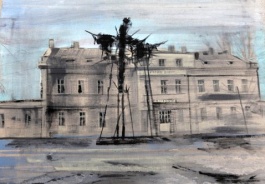
The exhibition presents a future memorial at the station in Bubny
 |
"The station itself is an exhibition attribute. It has the memory of the place from which over 50,000 Jewish citizens of Prague were deported to concentration camps,” states the project author, documentary filmmaker and director of the non-profit organization Holocaust Memorial Prague, Pavel Štingl. "There are many memorials of the past. There were times that built memorials for the future. What we need today - a memorial of the present? A place where the stigmas of the past and present can be openly discussed," he adds.
Directly at the Bubny station, the organizers plan to install a monumental object by sculptor Aleš Veselý at the beginning of next year. "The unveiling of the object will not only be a new sculpture in the public space of Prague, but primarily a message to the public and politicians that the concept for transforming the Bubny station into the Silent Memorial is ready for realization," Štingl stated.
The transformation of the Bubny train station in Prague into a modern memorial of contemporary history has been prepared by the Holocaust Memorial Prague since 2012. The completed project will bear the name Silent Memorial. The now non-functional building is expected to become a platform with a permanent exhibition, educational programs, seasonal exhibitions, and a space for meetings.
The non-profit organization Holocaust Memorial is expected to sign a 50-year contract with the station's owners, Czech Railways. According to the project organizers, Prague is one of the few European capitals that does not commemorate the victims of the Holocaust in public space. “We have a dignified memorial for the deceased who did not return from the transports, which are the names on the wall of the Pinkas Synagogue. But Prague lacks a center where these matters can be discussed,” Štingl said earlier.
From the Bubny train station more than half a century ago, people boarded Jewish transports. Near the station used to be a sorting station, and there is still a building here, a symbolic last station from which nearly 50,000 people were deported to their deaths.
The English translation is powered by AI tool. Switch to Czech to view the original text source.
0 comments
add comment
Related articles
0
22.08.2018 | The reconstruction of the station in Bubny into a Holocaust memorial will begin in September
0
21.09.2017 | In the future Memorial of Silence, an art gallery was created
0
12.10.2016 | The Silence Memorial will start to be built in the spring, and it is expected to be completed in 2018
0
20.01.2015 | The exhibition in New Town presents the Holocaust museum project











